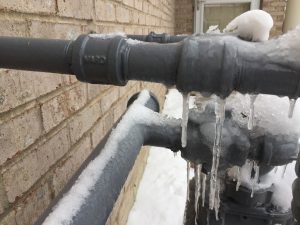Protecting Against Frozen Pipes in Cold Weather: Expert Strategies
Protecting Against Frozen Pipes in Cold Weather: Expert Strategies
Blog Article
We have stumbled upon the article involving Winter Plumbing Precautions: Preventing Frozen Pipes listed below on the web and felt it made good sense to relate it with you on my blog.

Winter can wreak havoc on your pipes, especially by freezing pipelines. Right here's how to prevent it from happening and what to do if it does.
Intro
As temperatures decline, the danger of frozen pipelines boosts, possibly causing expensive repair services and water damage. Recognizing just how to avoid icy pipes is critical for house owners in cold environments.
Avoidance Tips
Protecting at risk pipelines
Wrap pipelines in insulation sleeves or make use of warmth tape to shield them from freezing temperature levels. Concentrate on pipes in unheated or outside locations of the home.
Heating strategies
Keep indoor spaces adequately warmed, especially locations with pipes. Open up closet doors to permit warm air to circulate around pipes under sinks.
How to determine frozen pipelines
Search for lowered water circulation from taps, uncommon smells or noises from pipes, and visible frost on revealed pipelines.
Long-Term Solutions
Structural adjustments
Take into consideration rerouting pipes away from exterior wall surfaces or unheated locations. Add extra insulation to attic rooms, basements, and crawl spaces.
Upgrading insulation
Purchase top notch insulation for pipes, attics, and walls. Appropriate insulation helps keep constant temperatures and lowers the danger of frozen pipelines.
Shielding Exterior Plumbing
Garden pipes and exterior taps
Detach and drain pipes yard hoses prior to winter. Set up frost-proof spigots or cover outside faucets with shielded caps.
Recognizing Frozen Pipelines
What creates pipes to freeze?
Pipes ice up when exposed to temperature levels below 32 ° F (0 ° C) for expanded periods. As water inside the pipelines ices up, it expands, taxing the pipe wall surfaces and potentially creating them to break.
Threats and damages
Frozen pipes can lead to water interruptions, building damages, and costly repair services. Burst pipelines can flood homes and cause considerable structural damage.
Signs of Frozen Pipeline
Identifying icy pipelines early can avoid them from bursting.
What to Do If Your Pipelines Freeze
Immediate actions to take
If you believe frozen pipelines, maintain taps open to soothe pressure as the ice thaws. Use a hairdryer or towels soaked in hot water to thaw pipes slowly.
Verdict
Protecting against icy pipes requires aggressive actions and fast responses. By comprehending the causes, indicators, and safety nets, property owners can shield their plumbing during cold weather.
5 Ways to Prevent Frozen Pipes
Drain Outdoor Faucets and Disconnect Hoses
First, close the shut-off valve that controls the flow of water in the pipe to your outdoor faucet. Then, head outside to disconnect and drain your hose and open the outdoor faucet to allow the water to completely drain out of the line. Turn off the faucet when done. Finally, head back to the shut-off valve and drain the remaining water inside the pipe into a bucket or container. Additionally, if you have a home irrigation system, you should consider hiring an expert to clear the system of water each year.
Insulate Pipes
One of the best and most cost-effective methods for preventing frozen water pipes is to wrap your pipes with insulation. This is especially important for areas in your home that aren’t exposed to heat, such as an attic. We suggest using foam sleeves, which can typically be found at your local hardware store.
Keep Heat Running at 65
Your pipes are located inside your walls, and the temperature there is much colder than the rest of the house. To prevent your pipes from freezing, The Insurance Information Institute suggests that you keep your home heated to at least 65 degrees, even when traveling. You may want to invest in smart devices that can keep an eye on the temperature in your home while you’re away.
Leave Water Dripping
Moving water — even a small trickle — can prevent ice from forming inside your pipes. When freezing temps are imminent, start a drip of water from all faucets that serve exposed pipes. Leaving a few faucets running will also help relieve pressure inside the pipes and help prevent a rupture if the water inside freezes.
Open Cupboard Doors
Warm your kitchen and bathroom pipes by opening cupboards and vanities. You should also leave your interior doors ajar to help warm air circulate evenly throughout your home.

We were made aware of that article on Preventing and dealing with frozen pipes from a buddy on a different site. In case you enjoyed reading our blog posting please make sure you remember to share it. Thank you for your time. Don't forget to pay a visit to our website back soon.
Book A Free Estimate Report this page